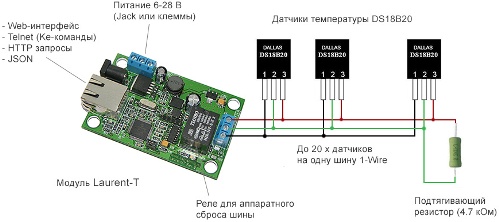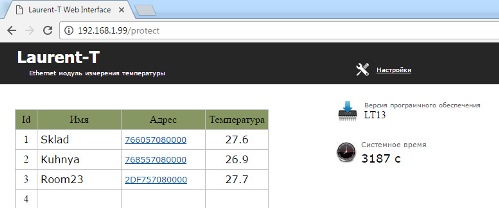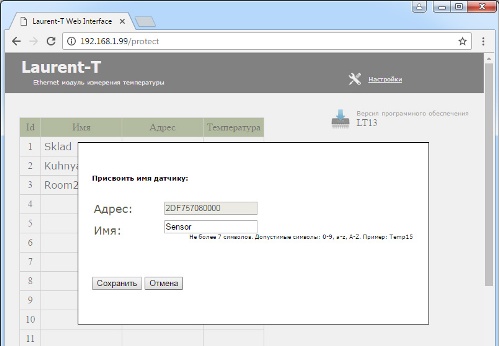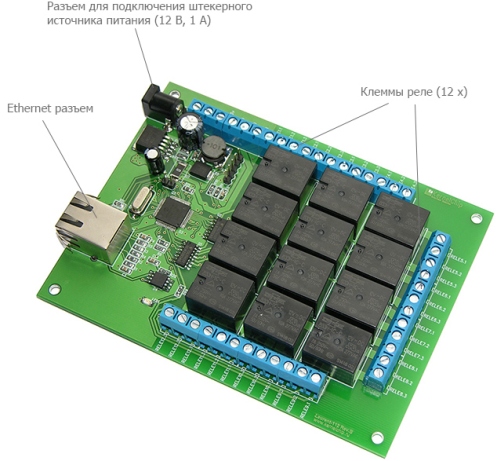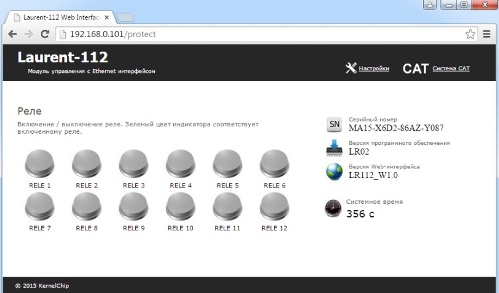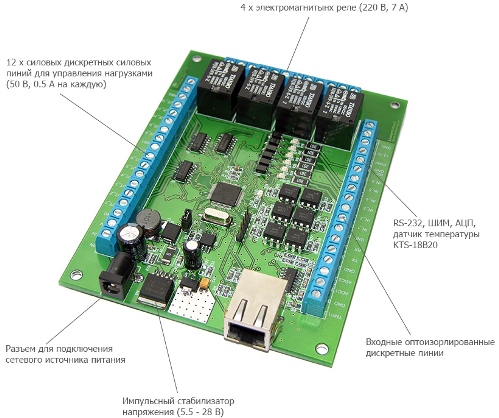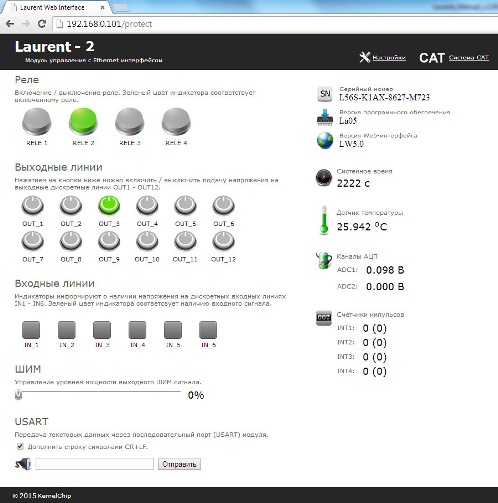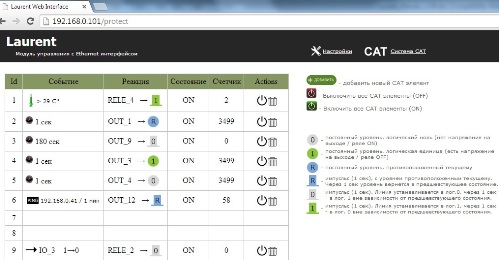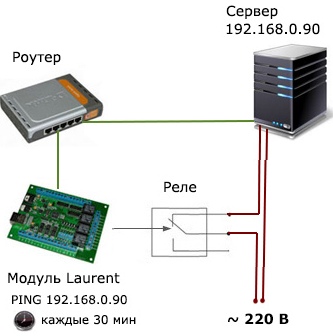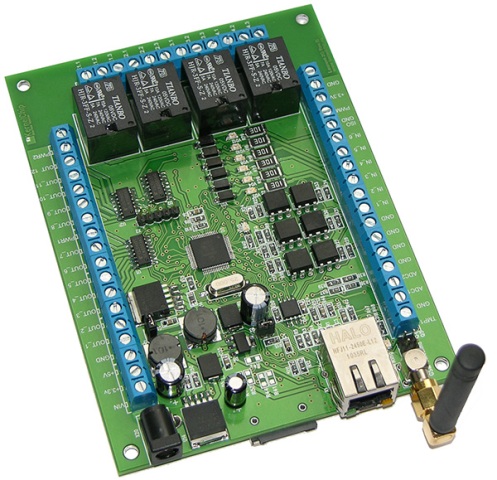Categories: Electrical Reviews
Number of views: 23407
Comments on the article: 0
Internet-controlled relays
In this short review, we consider four types of relays controlled via the Internet from the Russian company KERNELCHIP. For over 10 years, this company has been professionally developing and programming non-standard devices for interfacing with computers, as well as developing automation and control systems and remote control and monitoring systems via Ethernet and GSM / GPRS. Today, when the Internet is everywhere, such solutions are more relevant than ever. It will be about the controlled relays of the Laurent series.
Laurent-t
This module has a feature - a special purpose: collecting and transmitting, via Ethernet (LAN) interface, the readings of digital temperature sensors. The module is capable of working maximum - with 20 sensors of the Dallas DS18B20 type. Sensors are connected to a 1-Wire common bus.
Thus, Laurent-T is an Ethernet temperature controller that can work with 1 to 20 sensors, has a built-in web interface with a convenient table of sensor names (which the user can optionally set), with the possibility of hardware reset of the 1-Wire bus using built-in relay, while the command interface (API), of course, is open.
Often at the enterprise there is a need for group data collection from digital temperature sensors - in a centralized collection of readings. This is conveniently done remotely via an Ethernet network. After all, there is not always time to walk and collect bit by bit information from each of the dozens of digital temperature sensors connected via a 1-Wire bus. These are the tasks that the Laurent-T module helps to solve.
The readings collected from the sensors will be transmitted to the operator via the Ethernet network via the integrated web interface, XML / JSON or the command line (TCP port). Each sensor can be easily assigned a name according to the identification number of the sensor. The readings from the sensors are protected from short-term interference (characteristic of a long line) by smoothing and filtering. In the event of a malfunction on the bus, an automatic reset occurs using a relay. Thus, a large number of temperature sensors can be monitored and controlled remotely.
The built-in web page opens in any browser, you only need to enter the IP address of the module, which by default has the value 192.168.1.99, and the user will see a convenient visual interface for monitoring readings from all temperature sensors in real time. The table of sensor names will be stored in the non-volatile memory of the module.
Laurent-112
The Laurent-112 module is based on 12 relays for controlling various devices via Ethernet via a web interface or using an open command interface. There are 12 relays on the board, designed for switching voltage from 0 to 220 volts, with a current of up to 7 amperes. Each relay can be controlled separately. The CAT system allows you to implement a controlled reaction to events: by timer or, for example, in the absence of a response from a remote network device by PING command. The command interface (API) is open here.
The built-in web page for managing the module will open in any browser, just enter the IP address of the module, which defaults to 192.168.0.101. The interface is conveniently visualized, the relay status is visible (the button is on - green or the button is off - gray). The integrated web interface can optionally be password protected, which can be changed. The product delivery kit includes only the module itself, the power supply is purchased separately.
Laurent-2
This is a module with advanced functionality; it has rich hardware peripherals for controlling relays and for monitoring and tuning parameters of various devices over the network. Autonomous event processing is allowed (pulse counters, timer, PING, ADC, temperature sensor). Modules can interact with each other using special commands (see instructions) even without server involvement (M2M function).
The board is equipped with 4 relays for a maximum current of up to 7A.It has 4 pulse counters, 6 discrete inputs, 12 discrete outputs, a PWM output, RS-232, a 10-bit ADC pair, an input for a digital temperature sensor KTS-18B20, a CAT system - a controlled reaction to events, an open command interface (API) . Thus, this module is an improved and developed model of previous products with full preservation of the compatibility of connectors and commands.
The Laurent-2 module is suitable for controlling analog and digital devices, actuators and sensors over Ethernet. There are various ways of controlling the module: via the web interface, using direct http-requests, using text commands via the TCP port, using the data coming from the COM port, autonomously via the CAT system, and finally through M2M.
The control web page built into the module will work in any browser; its default address is 192.168.0.101. Here is a convenient visualized interface for managing various module resources and for monitoring its parameters online.
Using the CAT system, the module's responses to various events at its inputs are configured: when the temperature threshold is exceeded, by the pulse counter, by the timer, or when there is no response from the remote device to the PING command. The CAT system allows you to program the module and use it even autonomously without having to be connected to the network all the time.
Using the Laurent-2 module and the CAT system, you can quickly build a system for automatically monitoring the status of the server over the network and immediately reboot it if a "freeze" is detected. The server and Laurent-2 will be on the same subnet. Laurent-2 will periodically send a PING command to the server by its IP, and if there is no answer, an automatic power reset via the relay will be played.
Laurent-2 modules can be easily connected to a wireless Wi-Fi network via a Wi-Fi router. This combination of Laurent-2 module and Wi-Fi router allows you to control / manage the module from virtually any device equipped with a Wi-Fi interface at a considerable distance.
Laurent-2g
Laurent-2G module is a modified version of Laurent-2 module, just a GSM-modem is added with the ability to connect an antenna to it. Laurent-2G, like the previous model, is designed to control digital and analog devices, sensors and actuators via the Ethernet (LAN) interface, only here you can still control via the GSM interface - using SMS commands or DTMF tone commands.
See also at e.imadeself.com
:

